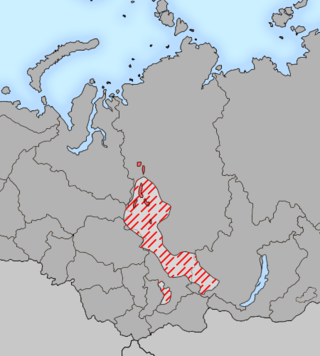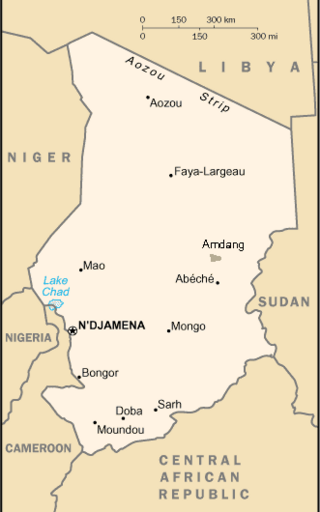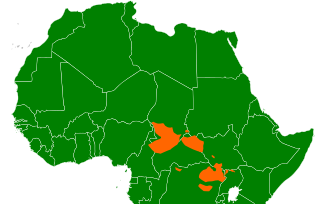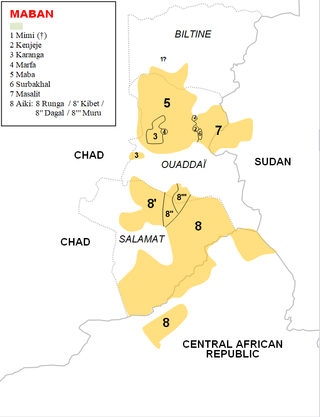Related Research Articles

The Altaic languages consist of the Turkic, Mongolic and Tungusic language families, with some linguists including the Koreanic and Japonic families. These languages share agglutinative morphology, head-final word order and some vocabulary. The once-popular theory attributing these similarities to a common ancestry has long been rejected by most comparative linguists in favor of language contact, although it continues to be supported by a small but stable scholarly minority. Like the Uralic language family, which is named after the Ural Mountains, the group is named after the Altai mountain range in the center of Asia. The core grouping of Turkic, Mongolic and Tungusic is sometimes called "Micro-Altaic", with the expanded group including Koreanic and Japonic labelled as "Macro-Altaic" or "Transeurasian".

The Nilo-Saharan languages are a proposed family of around 210 African languages spoken by somewhere around 70 million speakers, mainly in the upper parts of the Chari and Nile rivers, including historic Nubia, north of where the two tributaries of the Nile meet. The languages extend through 17 nations in the northern half of Africa: from Algeria to Benin in the west; from Libya to the Democratic Republic of the Congo in the centre; and from Egypt to Tanzania in the east.

The Yeniseian languages are a family of languages that are spoken by the Yeniseian people in the Yenisei River region of central Siberia. As part of the proposed Dené–Yeniseian language family, the Yeniseian languages have been argued to be part of "the first demonstration of a genealogical link between Old World and New World language families that meets the standards of traditional comparative-historical linguistics". The only surviving language of the group today is Ket.

Amdang is a language closely related to Fur, which together constitute a branch of the Nilo-Saharan language family. It is mainly spoken in Chad, north of the town of Biltine, and sporadically elsewhere in Ouaddaï Region. There are also small colonies of speakers in Darfur near Woda'a and Fafa, and in Kordofan in the Abu Daza district and at Magrur north of Bara. Most of the ethnic group now speaks Arabic.
The Bua languages are a subgroup of the Mbum–Day subgroup of the Savanna languages spoken by fewer than 30,000 people in southern Chad in an area stretching roughly between the Chari River and the Guéra Massif. They were labeled "G13" in Joseph Greenberg's Adamawa language-family proposal. They are ultimately part of the Niger–Congo family, and have exerted a significant influence on Laal.
An unclassified language is a language whose genetic affiliation to other languages has not been established. Languages can be unclassified for a variety of reasons, mostly due to a lack of reliable data but sometimes due to the confounding influence of language contact, if different layers of its vocabulary or morphology point in different directions and it is not clear which represents the ancestral form of the language. Some poorly known extinct languages, such as Gutian and Cacán, are simply unclassifiable, and it is unlikely the situation will ever change.

The Nilotic languages are a group of related languages spoken across a wide area between South Sudan and Tanzania by the Nilotic peoples.

Dené–Caucasian is a discredited language family proposal that includes widely-separated language groups spoken in the Northern Hemisphere: Sino-Tibetan languages, Yeniseian languages and Burushaski in Asia; Na-Dené languages in North America; as well as Vasconic languages and North Caucasian languages from Europe.

The Niellim language is a Bua language spoken by some 5,000 people along the Chari River in southern Chad. It is mainly spoken in two areas: one around the city of Sarh and one, its traditional home, further north, between about 9°30′ and 9°50′ N, corresponding to the former chiefdoms of Pra and Niou, as well as the Niellim Sultanate.
The Bua language is spoken north of the Chari River around Korbol and Gabil in Chad. In 1993 it was spoken by some 8,000 people. It is the largest member of the small Bua group of languages and is mutually comprehensible with Fanian. Kawãwãy (Korom) may be a dialect or a distinct language.
In most classifications, the Eastern Sudanic languages are a group of nine families of languages that may constitute a branch of the Nilo-Saharan language family. Eastern Sudanic languages are spoken from southern Egypt to northern Tanzania.

Central Sudanic is a family of about sixty languages that have been included in the proposed Nilo-Saharan language family. Central Sudanic languages are spoken in the Central African Republic, Chad, Sudan, South Sudan, Uganda, Congo (DRC), Nigeria and Cameroon. They include the pygmy languages Efé and Asoa.

The Maban languages are a small family of languages which have been included in the hypothetical Nilo-Saharan language family.
The Maba, also called Bargo or Wadai people, are a Sunni Muslim ethnic group found primarily in the mountains of Wadai region in eastern Chad and southern Sudan. Their population is estimated to be about 542,000. Other estimates place the total number of Bargo people in Sudan to be about 28,000.
The Northern Eastern Sudanic, Eastern k Sudanic, Ek Sudanic, NNT or Astaboran languages may form a primary division of the proposed Eastern Sudanic family. They are characterised by having a /k/ in the first person singular pronoun "I/me", as opposed to the Southern Eastern Sudanic languages, which have an /n/. Nyima has yet to be conclusively linked to the other languages, and would appear to be the closest relative of Ek Sudanic rather than Ek Sudanic proper.
Mimi of Nachtigal, or Mimi-N, is a language of Chad that is attested only in a word list labelled "Mimi" that was collected ca. 1870 by Gustav Nachtigal. Nachtigal's data was subsequently published by Lukas & Voelckers (1938).

One Hundred and One Nights is a book of Arabic literature consisting of twenty stories, which presents many similarities to the more famous One Thousand and One Nights.
Mimi is a name applied to several at-best distantly related Nilo-Saharan languages of the Wadai area of Chad. It is most commonly used for the Fur relative Amdang, with several tens of thousands of speakers, but also for two extinct and possibly Maban languages, Mimi of Nachtigal and Mimi of Decorse.

Maurice Gaudefroy-Demombynes was a French Arabist, a specialist in Islam and the history of religions.
The Evolution of Human Languages (EHL) project is a historical-comparative linguistics research project hosted by the Santa Fe Institute. It aims to provide a detailed genealogical classification of the world's languages.